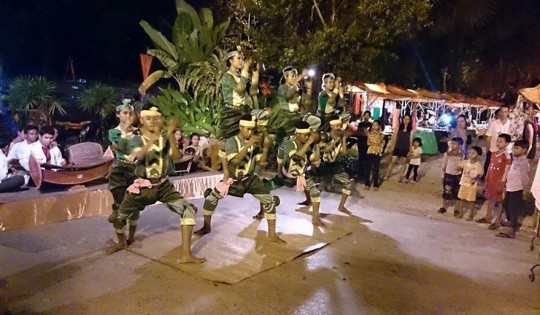This is a traditional folk dance from Svay Rieng province. The gestures of this dance generally imitate the praying mantis, and costumes are the color of the insect. Coconut shells are used during the performance, with pairs of empty shells tied to the dancers’ hands and elbows.

According to Inventory of Intangible Cultural Heritage of Cambodia Book, Traditional Folk Dance Refers to all kinds of dances that are passed on from one generation to another and that is often linked to an ethnic group’s traditional’ ceremonies. In Cambodia, traditional dances mostly involve animism and express beliefs in the supernatural. When people have problems thought to have been caused by supernatural or spirits, they offer lively dances to appease them.
Folk dances are performed at religious ceremonies, festivities, and for leisurely entertainment. Traditionally, all dances were performed in the village in large clearings or public areas at times of birth, marriage, death, during planting and harvesting, hunting, war, or at a feast. Some dances are related to Buddhist beliefs such as Kgnork Pailin and Trot dances. Others are performed once a year according to various spiritual and ceremonial calendars.
Khmer folk dances are highly spirited dances that follow popular themes with lively movements and gestures. Dance motifs are usually based on local legends and the everyday life of the people. Dancers dance with easy, improvised yet composed movements that are designed to invite humor and enthusiasm, with upbeat music and rhythm. Many dances are accompanied by drums and instruments from the Mahori and Pinn peat ensemble.
The Robam Kandob Ses is the traditional dance that originates from Chup Village, Kandeangreay commune, Svay Teap district, Svay Rieng Province. It was performed in 1920.
Stated by some of the older artists include Lok Ta (Grandfather) Sous Va born in 1917, Lok Ta Norng Saroeun born in 1939, and Lok Yeay (Grandmother) Som Thorn born in 1955, Chup village, Kandeangreay commune, Svay Teap district; who are the students to Master Man Sum claimed that Master Man Sum had created this Grant Mantis dance in 1920 after the coconut shell dance.
The gestures of this dance largely imitate the praying mantis. The number of dancers depends on how many dancers are available, and costumes are designed with praying mantis colors. Coconut shells are used during the performance as pairs of empty coconut shells are tied on the dancers’ hands and elbows, this lively dance is accompanied by the beat of drums, a singer, and the singing melody of the kse diev, a traditional stringed instrument. In later generations, more instruments haw been added such as the tro (string fiddle) and roneat (xylophone).
The same source added that Robam Kous Trolaok is different from many other traditional folk dances where they often bridged the ethnicity to the spiritual belief. However, this dance has been used by the Cambodian people in Svay Rieng province to participate in the wedding ceremony, especially for groom procession in order to create a pleasant atmosphere and prompted the ceremony more pomp. This dance similar to coconut shell dance according to Khmer preference, they dance in the wedding is the creation of a happy and glory because this “Trolaok Nhi-Chhmoul” for Cambodian people believes as a symbol of natural properties, especially its agricultural production of the nation. Moreover, “Trolaok Nhi-Chhmoul” represents water and soil, which is the favorable condition for agriculture, and also the bond between adults, which is the prerequisite condition for morality in rural life.
And, female and male dancers hold each pair of beautifully polished coconut shell and often called “Trolaok Nhi-Chhmoul”. Then, they were dancing to traditional rhythms (Phleng Kar) with dynamic movement and cross open like a grasshopper with humor and naughty performance.
Gallery
Reference
- MCFA & UNESCO (2004). Inventory of Intangible Cultural Heritage of Cambodia: A joint publication of the Ministry of Culture and Fine Arts and UNESCO. Cambodia: JSRC Printing House.
- វ៉ាន់ ប៊ុនធឿន (២០១៨,មេសា ១៨). ប្រវត្តិរបាំកណ្តូបសេះក្នុងវង់សិល្បះ. Retrieved from https://kohsantepheapdaily.com.kh/article/625778.html






